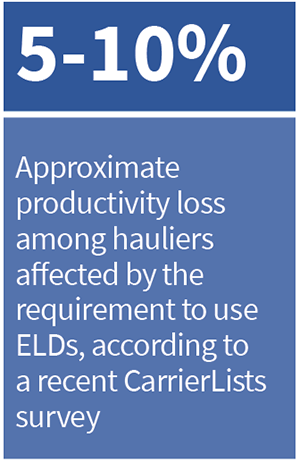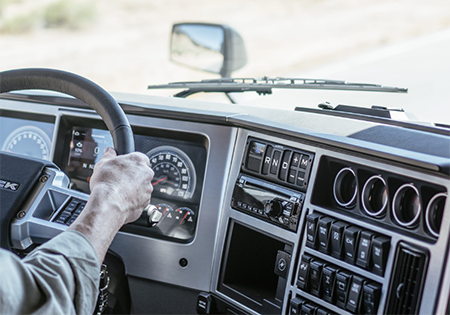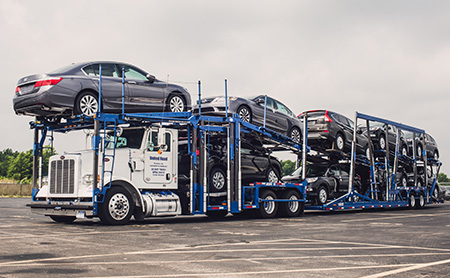 This time last year, the trucking industry and its customers were just settling into compliance with a mandate from the Federal Motor Carrier Safety Administration (FMCSA) that required electronic logging devices (ELDs) on commercial vehicles with a gross weight of over 10,000 pounds (4,500kg).
This time last year, the trucking industry and its customers were just settling into compliance with a mandate from the Federal Motor Carrier Safety Administration (FMCSA) that required electronic logging devices (ELDs) on commercial vehicles with a gross weight of over 10,000 pounds (4,500kg).
In the months preceding the initial deadline, predictions varied widely about the impact of ELDs on truck capacity and the transport market. A few weeks ahead of the December deadline, the FMCSA, responding in part to concerns from state authorities regarding enforcement training and the variety of ELD systems in the market, opted to have an initial phase-in period, with a deadline extension throughout the first quarter of 2018 for the installation of the devices.
 By the time the December 2017 implementation deadline arrived, it was not the cataclysmic event some had feared would strand trucks on the side of the road, nor did it remove significant capacity from an already constrained market struggling to meet the logistical needs of a booming American economy. Even since the April 1, 2018 hard enforcement deadline, the actual impact of ELDs has been much subtler.
By the time the December 2017 implementation deadline arrived, it was not the cataclysmic event some had feared would strand trucks on the side of the road, nor did it remove significant capacity from an already constrained market struggling to meet the logistical needs of a booming American economy. Even since the April 1, 2018 hard enforcement deadline, the actual impact of ELDs has been much subtler.
“There was a lot of talk in the run-up to the December deadline. No one was really sure what was going to happen with capacity,” says Kevin Hill, president of CarrierLists, which began weekly polling of small and mid-sized fleets about their ELD plans and compliance several months ahead of the December 2017 deadline.
Some 75% of the fleets CarrierLists polled were ready with e-logging systems ahead of that deadline – up from just 50% in October. In the final ELD poll conducted by CarrierLists in the week following the full implementation in April, 97% of fleets had compliant systems.
“As soon as April 1 arrived, it was basically business as usual. There were changes with the ‘tweener’ lanes [400 to 600-mile routes], but there were no huge disruptions in the supply chain. The supply chain adjusted, and drivers are now driving with ELDs on their trucks,” comments Hill.
Measuring timeELDs have brought about some changes in terms of the way a commercial vehicle driver’s work and rest periods are measured, however.
The most immediate impact has been a heightened awareness of available driving times and duty times, both daily and cumulatively. Electronic logging has eliminated the option of ‘stretching’ time via ‘creative’ paper log entries, and its stricter limitations have generated additional costs for carriers.
“As soon as April 1 arrived, it was basically business as usual. There were changes with the ‘tweener’ lanes [400 to 600-mile routes], but there were no huge disruptions in the supply chain” - Kevin Hill, CarrierLists
Apart from the expense of installing the devices and training drivers, there has also been a loss of productivity. Some industry estimates put this at 3-5%, though CarrierLists surveys during 2018 suggest it could be more like 5-10%.
In some cases, drivers have been tempted to leave the industry rather than comply with the new mandate, given the US’s strong economy and buoyant general labour market. Discussions between carriers and customers about particular contracts, meanwhile, have had to focus more on the value of a professional driver’s time, rather than just capacity and rates.
Contesting the changeSome bodies, like the Owner-Operator Independent Driver Association (OOIDA), have argued long and hard against the introduction of the new rules (see Taking hours of service seriously below), suggesting that ELDs are unfair to smaller companies. But the impact does seem to have varied from sub-sector to sub-sector.
“When you look at the automotive supply chain related to the hours of service (HOS), we see lanes in the south-east and Midwest, going down to Mexico. Or, we see the inverse with flows coming up from Mexico to final assembly facilities in the Midwest, south-east and Canada,” observes Bob Poulos, CEO of V3 Transportation, a firm with 250 trucks that has been ELD-compliant since its launch in 2013.
 “Most of the hefty lengths of hauls are serviced by teams, and that business has not been impacted over the past year,” he adds. “However, I do believe the automotive supply chain has experienced a bigger impact with the length of haul that is between 500 and 700 miles.”
“Most of the hefty lengths of hauls are serviced by teams, and that business has not been impacted over the past year,” he adds. “However, I do believe the automotive supply chain has experienced a bigger impact with the length of haul that is between 500 and 700 miles.”
Poulos says OEMs and tier suppliers can no longer put solo drivers on runs exceeding 500 miles, and that those moving perishable products have had to make some significant changes as a result.
“Drivers on paper logs would push it where they could,” says Poulos. “As a solo driver, it’s very hard to do 600 miles legally in a day. That’s where a lot of the cheating was taking place, and that’s where one of the impacts has been during the past year.”
Counting the costThe cost of compliance with the new regulations was one of the factors that made large truck capacity more expensive in the US last year, as pay rises swept across the industry to cover lost miles of earnings for drivers.
In addition to this, carriers faced competition for staff from other industries adding jobs within a strong US economy, tightening capacity further due to heightened demand across multiple industry verticals.
One of the concerns expressed by the OOIDA prior to the initial December deadline was that its members, particularly those close to retirement age, would simply park their trucks up and find work in other industries, rather than go through the time and expense of converting to an e-log system.
OOIDA president Todd Spencer says the association has seen an increase in departures from the industry during the past year. “We’ve heard from lots of drivers who have simply said: ‘I’m not going do this any more. I can do as well or better in lots of other things’,” he says. “And there certainly are those kinds of opportunities now. We have had a lot of people who have moved into the fracking business and things like that. Construction’s also pretty good.”
Customer frictionSome fleets have also had problems with their customers as a result of the introduction of ELDs.
[mpu_ad]One long-time fleet executive who asked to not be identified told Automotive Logistics about one of the big three US OEMs issuing a bid package for a full truckload service in 2018, but ultimately pulling it due to the price increases and time requirements outlined by carriers bidding on the business.
“The OEM essentially threw out the bid. They didn’t like the results and it was like, ‘Can’t we go back to what we were doing before?’,” says the fleet executive. “But here’s the reality of the situation: contract rates are up, commensurate with contract grades; and contract rates for automotive are up, commensurate with what we’re seeing across the board in all industries.”
The use of time has also become a significant consideration in itself for carriers and their customers. The just-in-time, just-in-sequence nature of the automotive supply chain gives it an advantage over other industries, where loading and unloading delays have long been an issue for truck fleets looking to keep their drivers moving.
Penalty clauses for such delays have been around for years but have often lacked bite, not least as creative paper logging could cover any time lost. With ELDs, however, that has all changed, leading some carriers to put detention criteria into place that are sufficiently strong to change customers’ loading and unloading patterns.
“When looking at some of the more significant changes beyond rates, there’s been a big move in the automotive segment this year, led by a lot of the larger fleets, to go back down to one hour of detention, with charges starting after the first hour,” confirms Poulos. “It had universally become the norm to go out to two hours, sometimes three hours before detention charges began. But after the ELD mandate, one hour has really become the norm again.”
Data released in November from a survey of drivers by fleets using the services of CarrierLists revealed that nearly 72% of responding drivers had seen a decrease in their driving hours; while 42% felt they had experienced a decrease in privacy, due to the use of ELDs.
 In January 2018, Tranco Logistics – a Tennessee-based warehousing and transport company with a fleet of 175 trucks – was one of many carriers going through the transition from paper to ELDs.
In January 2018, Tranco Logistics – a Tennessee-based warehousing and transport company with a fleet of 175 trucks – was one of many carriers going through the transition from paper to ELDs.
The firm, which services Volkswagen’s (VW) plant in Chattanooga and has approximately 100 trucks working in the area of automotive, did not hold back like some in the hope that implementation would be delayed beyond December 2017.
Instead, it began working in 2016 with PeopleNet, its satellite communications provider, on a plan to fit its entire fleet with ELD systems ahead of the deadline, including driver and office staff training.
By early November last year, all of Tranco’s trucks were using PeopleNet’s ELD system. On top of its investment in time and training, the carrier had to spend $2,000 per tractor for the ELD hardware and software.
“The transition was tough, with equipment changes and re-training drivers,” comments Bruce Trantham (shown left in the picture above), who co-founded Tranco in 1995. “We had to make the investment and there was a big learning curve.
“We [the trucking sector] have always been regulated. If you look at the government, it’s about the checks and balances, and this is part of the checks and balances. I’m glad we didn’t wait. We had a plan [for implementation] and we stuck to our plan. It will help us to make improvements to our processes, but there was monetary cost to this change.”
In developing its plan for ELD implementation, Tranco could see it needed to do more for drivers than just address the anticipated earnings gap, in order to make being away from home more financially attractive. In addition to keeping its long-haul fleet drivers from looking at working in other industries, it realised that it also needed to address pay rates for short-haul drivers who get home every night, and so moved to increase their rate by $4 per hour.
Furthermore, Tranco went to its customers to renegotiate its haulage rates, including VW, for which it makes regional runs to and from tier suppliers, as well as three VW suppliers for whom it provides space for wheels and tyres, fuel tanks and mirror assemblies.
“I would say that the customer is generally still in a process of learning, but they [VW] are logistics guys and they get it,” says Trantham of the transition process to e-logs and the costs. “They understand this is not our rule and that it affects everybody.”
“I’m all for the free market and less regulation, but I think ELDs will help safety,” he continues. “People do not realise sometimes what they’re running up next to on the highway. They can be going by a professional driver and it’s someone who is doing it right. You can also be next to a driver who’s been on the road for 17 hours and he’s one hour away from a delivery or going home.
“You and your family don’t want to be next to the person who is over his hours on the highway. ELDs will keep that person off the highway – and that’s the right thing to do,” he concludes.
“The biggest dilemma that drivers have always had is not the time they spend driving – it’s the time that’s simply wasted in the loading and unloading environments,” says Spencer. “Now, in some instances, [the change to ELDs] has translated into a little bit of better treatment at shippers and receivers in terms of getting trucks in and out. But that’s not necessarily been across the board. We’re also in a situation where we have no flexibility with the hours of service and now you’ve got this thing that you’re absolutely locked into with the machine and e-logs.”
Enforcement challengesEnforcement of the HOS rules under the new ELD regime has also been far from simple.
From a distance, the new electronic platform has greatly simplified the process. Highway patrol or local law enforcement officials can simply connect to the driver’s ELD and review the data entries made by the system. But with more than 400 ELD systems on the market in the run-up to the implementation deadline in December, law enforcement bodies have had a steep learning curve, with a requirement for training among their staff at least as big as that facing drivers and fleet operators.
The Commercial Vehicle Safety Alliance (CVSA) – a non-profit association comprising local, state, provincial, territorial and federal commercial motor vehicle safety officials and industry representatives – has been watching the implementation with interest over the past year, and points out that, in addition to the multitude of new ELD systems on the market, the FMCSA e-log mandate allows carriers using legacy Automatic On-Board Recording Devices (AOBRDs) a grace period until December 2019 before their trucks are required to have an ELD.

“Everybody’s in kind of an education mode right now – whether it’s an inspector talking to a driver or working through the challenges with electronic hours of service. That’s why when you look at the stats online, those being reported from FMCSA and others, we are seeing historic lows for hours of service violations right now,” explains Collin Mooney, CVSAs’ executive director.
In some cases, notes Mooney, drivers believe they have an ELD and it is actually an AOBRD. But enforcement officers cannot always connect to an AOBRD, because the data collection technology is different.
Inspectors have also encountered data transfer issues, frustrating both enforcement officials and drivers. The FMCSA allowed ELD manufacturers to self-certify their devices rather than using third-party verification, and this has led to some platforms being a bit hit-or-miss – resulting in some drivers failing to comply with HOS rules through no fault of their own, and inspectors deciding not to pursue a hard enforcement line where they believe drivers have been making a reasonable effort to comply.
“I think we have one member who actually is now on his third unit,” says Spencer of OOIDA. “And with the other two units he had, those companies have both ceased doing business. There are lots of problems with the technology not performing as well as you would hope, Generally, enforcement has been kind of tepid.”
 Mooney also concedes that some enforcement officials “are taking a leap of faith that the ELD is keeping people more honest than they were in the past. So, they’re not digging as deep into the electronic record of the ELD.”
Mooney also concedes that some enforcement officials “are taking a leap of faith that the ELD is keeping people more honest than they were in the past. So, they’re not digging as deep into the electronic record of the ELD.”
Another concern for law enforcement has been ELD exemptions that have allowed some segments of the industry to continue using paper logs. All law enforcers can really do about this, says Mooney, is take the long view that the transition from paper to e-logs will move past what has been an extended period of adjustment.
“We’re in this ebb and flow period right now. Some of the things have smoothed out and some of the things are still frustrating until we get them resolved,” he says. “We’ve done the best we can under the circumstances.”
The road aheadGiven the inflexibility, ELDs have prompted further discussion about the hours of service regulations themselves. The FMCSA, for example, has been holding public listening sessions as part of a consultation period on an Advanced Notice of Proposed Rulemaking related to the hours of service.
Mooney anticipates some “big changes” as a result of this process, and Spencer is hopeful that the FMCSA will address some of the rigidness that currently exists within the HOS regulations. The OOIDA has submitted comments and hosted one of the FMCSA listening sessions.
“Compliance with the (current HOS) regulations too often means drivers are driving in the middle of rush-hour traffic. Compliance with the regulations oftentimes means that drivers are driving faster than they would prefer to drive on certain roads and in certain traffic and weather conditions – simply because the goal is compliance with the hours of service regulations,” notes Spencer.
“Our proposal for more flexibility… [would] allow a driver to take a three-hour break, if they need to for whatever reason. It doesn’t give them more hours to drive, but it extends the time that they’re able to drive within their normal hours. Now, having said all of that, flexibility would be nice in a whole lot of situations.”
 Carriers hope a balance will eventually be struck between ELD compliance and hours of service regulations, allowing drivers more flexibility
Carriers hope a balance will eventually be struck between ELD compliance and hours of service regulations, allowing drivers more flexibilityELD implementation over the past year has not changed the OOIDA’s views and the association will continue to be vocal about the matter, promises Spencer. “We remain concerned about the constitutional aspects of monitoring and surveillance. And I think far more people ought to be concerned about those things because the government and its efforts in this area are pretty damn scary,” he observes.
“We also remain concerned that while the US Supreme Court may not have given that issue the consideration that they should have, each of these regulations all have to pass muster with state constitutions as well. And we are advised that not all state constitutions are likely to be as permissive about surveillance as some in DC would like them to be.”
One year on, it seems the road ahead for electronic logging devices in the US still has a number of dangerous potholes in it that will need to be circumnavigated with care.
 “Compliance with the regulations oftentimes means that drivers are driving faster than they would prefer to drive on certain roads and in certain traffic and weather conditions – simply because the goal is compliance” - Todd Spencer, OOIDA
“Compliance with the regulations oftentimes means that drivers are driving faster than they would prefer to drive on certain roads and in certain traffic and weather conditions – simply because the goal is compliance” - Todd Spencer, OOIDA
 Aimed at ensuring that drivers of large vehicles do not drive when tired, hours of service (HOS) rules in the US restrict drivers of commercial vehicles over 10,000 pounds to 14 hours’ duty a day, of which 11 may be spent driving. There are also rules about cumulative working and driving hours over an eight-day period; daily rest periods; and extended rest periods (at least 34 hours after a driver reaches certain limits over a consecutive number of days).
Aimed at ensuring that drivers of large vehicles do not drive when tired, hours of service (HOS) rules in the US restrict drivers of commercial vehicles over 10,000 pounds to 14 hours’ duty a day, of which 11 may be spent driving. There are also rules about cumulative working and driving hours over an eight-day period; daily rest periods; and extended rest periods (at least 34 hours after a driver reaches certain limits over a consecutive number of days).
The HOS regulations date back to the 1930s, when the US government first placed limits on the number of hours that could be worked by commercial drivers. Before the advent of satellite communication and other technological advancements on commercial vehicles, professional drivers accounted for their time behind the wheel and their number of hours on duty with paper log books. In the 1990s, electronic logging systems began to gain traction among larger truck fleets, however.
One of the main advantages of e-logs for a large fleet is the real-time view they can provide of all the available hours for all of its drivers. As logistics management systems became more advanced, this allowed fleets to look at the locations of their trucks, factor in the number of hours each driver had available and create greater efficiencies in the overall use of time and equipment.
Electronic logging systems are essentially just data collectors; there is no allowance for interpretation or ‘creativity’ by drivers or fleets. It is a strict system that collects data about a driver’s working time, driving time and breaks.
While the trucking industry had made great strides in terms of compliance, paper logs had kept the door open to abuse. Using paper systems, drivers could easily find ways to cover up time lost idling in traffic jams, for instance, or waiting to be loaded or unloaded.
Mixed receptionSince it was first proposed more than eight years ago, the ELD mandate has been one of the most contested changes in the history of the US trucking industry. Some, like the American Trucking Associations (ATA), have welcomed it as a universal way to account for drivers’ time and thus improve road safety by forcing them to adhere to the HOS regulations. Others, like the Owner-Operator Independent Driver Association (OOIDA), have suggested that it causes hardship for small businesses due to the equipment investment required.
“The ELD requirement pretty much requires rigid, minute-to-minute compliance with the regulations. What has become really obvious is that, for lots of people in trucking, that isn’t terribly practical,” says Todd Spencer, president of the OOIDA. “Big fleets have used this technology for a long time. It adds cost and regulation to their competition. It’s a benefit to the big fleets. Among the benefits to them are increased productivity, in that they have technology that can tell if the truck’s moving. Of course, now they’re going to have the technology to know if their driver has hours to drive. And if the truck’s not moving, they want to know why.”
In addition to concerns about equipment costs and the possibility that carriers could force drivers to work against their will if they have available hours, the OOIDA made an argument in court about privacy concerns, in a successful legal challenge to the FMCSA’s initial ELD mandate. The FMCSA reworked the regulations in light of that court ruling. The OOIDA, meanwhile, pursued additional legal challenges against the mandate until 2017, when the association’s bid to have the Supreme Court hear the case was denied.
Despite the OOIDA’s efforts to that point and subsequent lobbying for legislation to delay implementation of ELDs, it was clear prior to the fourth quarter of 2017 that professional drivers and carriers needed to be prepared for the implementation deadline that December.
Topics
- American Trucking Associations
- ata
- CarrierLists
- Commercial Vehicle Safety Alliance
- CVSA
- Digitalisation
- features
- Federal Motor Carrier Safety Administration
- FMCSA
- North America
- North America
- OOIDA
- Owner-Operator Independent Driver Association
- Policy and regulation
- Ports and processors
- Road
- Topics
- United States Of America
- V3 Transportation
- Volkswagen

























![Global[1]](https://d3n5uof8vony13.cloudfront.net/Pictures/web/a/d/s/global1_726550.svgz)












